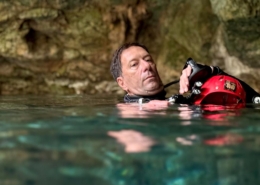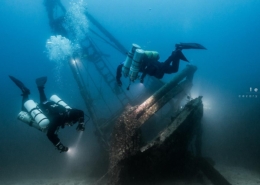Why the Biology of “Muck” Shouldn’t be Overlooked
By: SDI Ambassador Justin Carmack
From TV Screens to the Depths
Credit should be given where credit is due. Let’s face it: the spectacular scenes on TV when we were kids of big beautiful reefscapes on National Geographic episodes or wildlife channels showing us scenes with sharks and dolphins is what got many of us interested in exploring underwater in the first place. These are fascinating visuals that most people do not get to see in their daily lives, and if you are anything like me, you get a deep desire to see and experience more and more.
So you find an SDI dive shop in your area or at your next vacation destination, and you get certified to dive to start experiencing these things yourself.
But your first time descending the depths to encounter a school of jacks, or maybe a seahorse face to face, is a gateway drug. Your first time seeing these most fascinating species and scenes will certainly not be your last. You’re now addicted and wonder what else is out there.
This is what happened to me. I was backpacking around Africa in 2010 and decided to learn to SCUBA dive while in Tofo, Mozambique. My life was never the same again. The next couple weeks were spent with manta rays, whale sharks, humpback whales, and fields of fragile corals in every shape and color imaginable. Saying I was hooked is an understatement.
Now, I started making friends over the years who were into the same thing: diving and marine biology. I remember that we would compare stories of what we had seen in a particular region of the world, and when I would be shown a species that they had seen that was new to me, I instantly had to go there and find it.
Becoming a Critter Hunter: The Transformation
That desire to search and discover a massive variety of species all over the globe led to me learning to film them so I could document such things. It taught me the actual biology, habitats, migrations, and many other things that differ from region to region. In a nutshell, every dive, every dive trip, turned into a vast treasure hunt. There is nothing more exciting than hunting for treasure (observe your kids on the next Easter egg hunt), and critters were now my treasure, and there was/is no limit to how much you can find.
I would arrive at a place like Raja Ampat and hunt for the elusive epaulette and wobbegong sharks. Then, off to South Africa to search for the newly discovered pygmy seahorse, then over to Anilao to see if I could film a variety of rhinopia species.
My list was long for the things I wanted to film in the wild, and there is nothing more exciting than finally finding that species for the first time and getting good footage. For a critter hunter who wants to film a wide variety of exotic and not very well-known species, one soon learns that it is NOT those big beautiful fields of reef where you find them, but the opposite: in what seems like barren wastelands of sands and silt, or what divers call: The Muck.
Dauin, Philippines: A Biodiversity Hotspot for Muck Diving
So thank you, Blue Planet and National Geographic, for showing me those pretty images to get me interested in the ocean, but now, let’s talk about muck diving.
Muck Diving is a treasure hunt with unlimited surprises.
In the interest of NOT making this article a long rambling of an over-excited and passionate critter hunter who has just been asked what can be found on a muck dive, I will use one tropical region of the globe as my example: The Philippines. Because of my love for the wide variety of biodiversity of Philippines muck diving locations, I am now based in Dauin, in the Western Visayas.
I love many things about Dauin, but of course, the biggest draw for me is that I always have something to see on a dive, with close to 1,000 dives over less than a dozen sites. I can dive into one site for a month straight, and still, on each dive, I will find something I have yet to see.
How can this number of small creatures be possible when I survey one small area daily and still find more? You can see why each dive is like a treasure hunt. It’s even better than a treasure hunt because although I am confident I will see SOMETHING, I only know what it is once it surprises me.
Beyond Sharks and Manta Rays: Embracing the Smaller Wonders
People on my channel always ask me why I don’t film sharks or like to dive with them—or dolphins or manta rays. Well, the answer is I love those things as well. But as exciting as diving with a school of manta rays is, you would get bored if you did that every day. As hard as that is to imagine, it’s true for me.
For example, I spent some time in Komodo, where I did nothing but dive with giant manta rays every day for two weeks. It was my first encounter with them, so that was a massive rush. But after a while, you get used to it, become desensitized, and no longer appreciate how amazing they are.
I spent two dives a day for two weeks, hovering in front of a cleaning station, filming up to 11 manta rays dancing in front of me. It was magical, but after a while, you wonder, “What else is there to experience?” You know what I mean… If I only filmed those for each episode, my viewers would love the first video or two, but they would also want more variety. The 50th time of something great is less remarkable than the first.
Every Dive is a First: The Thrill of Muck Diving
With muck diving, every dive has firsts. I get fantastic footage of things on every dive I do now, and in every comment section of every video, someone is sure to say, “That is the first time I’ve ever seen/heard of one of those.” If it’s exciting for you to watch on screen the odd behaviors of a hairy frogfish or the mating habits of a seldom-seen pair of undescribed nudibranchs, imagine how I feel seeing them in person on every dive.
You don’t have to be a naturalist or a marine biologist to be interested in seeing marine species that 99.99% of the world has never seen in person. You have to be a kid with that love and fascination for encountering eye-to-eye with some of the rarest, most under-appreciated, under-studied, and flat-out unknown species on the planet.
So I’ve been scratching my head, wondering how I could cover how fantastic a critter hunting excursion to a muck site can be, but there is only one way to put it into words: by making it into a book. So, I decided to create this documentary about muck diving that will give you a small taste of the insane biodiversity you can find here on my tiny island in the Philippines.
There won’t be a single shark, dolphin, or turtle in this documentary, but I can guarantee that there will be AT LEAST one critter here that even you have never seen before.
Want to explore beneath the waves with the critters in your own backyard? Sign up for an SDI Marine Ecosystems Awareness to see what could be hiding in the muck!
Justin Carmack is an SDI Ambassador and Instructor located in Dauin Philippines. To keep up with his critters or go treasure hunting with him check out his website and follow him on Instagram and Youtube.













Leave a Reply
Want to join the discussion?Feel free to contribute!